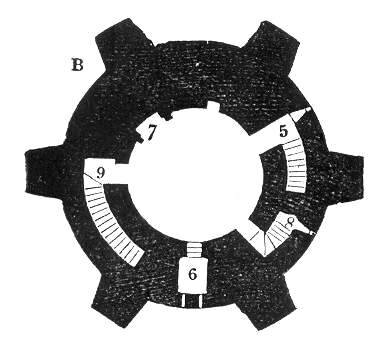Conisbrough Castle
continued
Extract

Conisborough Castle, which is pronounced by Mr King to be of the earliest Saxon times 'before the conversion of that people to Christianity', is held by later antiquaries in its extent and arrangement to be a fair representation of the Norman keeps of the smaller class.
It is situated in the West Riding of Yorkshire, in the wapentake of Stafforth, arid, standing on a steep knowl, commands a splendid view of the winding course of the river Don. It was formerly entered by a drawbridge over a deep fosse. Leland speaks of the castle standing on a rocket of stone, and ditched. The walls of it have been strong and full of towers.By the walls the old topographer means those which surround the keep, which Pennant in his time described as seemingly circular, and having the remains of four small rounders.
The keep, of which a good part is still entire, is a most remarkable building. It was originally four stories high and is of a circular form, being about twenty-two feet diameter inside. The walls are fifteen feet thick, and they are flanked by six projecting turrets, or square buttresses, running from the top to the bottom, and expanding at the base. The external appearance of the keep does not at first give the impression of its really circular form.
The ground floor or base is described by Pennant as a noisome dungeon of vast depth, at the bottom of which is a draw-well.

Fig. A exhibits the form of the second story: the steps are numbered 1, the entrance 2, the stairs to the third story 3, the opening to the vaulted story or dungeon below 4.
 Fig. B shows the third story; the stairs from the second floor are numbered 5, the window 6, a closet which shows that our forefathers possessed conveniences which have been thought a modern invention 8, stairs to the fourth story 9; the chimney is numbered 7, and in this and the floor above it is remarkable that the construction of a chimney was not only perfectly well known, but that the form of the opening projecting over the hearth exhibited a degree of elegance which might recommend itself to the tasteléss fire-place builders of eight centuries later .
Fig. B shows the third story; the stairs from the second floor are numbered 5, the window 6, a closet which shows that our forefathers possessed conveniences which have been thought a modern invention 8, stairs to the fourth story 9; the chimney is numbered 7, and in this and the floor above it is remarkable that the construction of a chimney was not only perfectly well known, but that the form of the opening projecting over the hearth exhibited a degree of elegance which might recommend itself to the tasteléss fire-place builders of eight centuries later .

 The fourth story is indicated in Fig. C; a small but well decorated hexagon room, undoubtedly used as a chapel, formed out of the thickness of the wall and the turret, is numbered 10, the stairs from the the third floor 11, the window 12, the chimney 13, the stairs to the platform 14. From this platform there are entrances to small rooms formed in the six turrets which rise above theparapet. Such were the conveniences of one of the smaller keeps, possessing only a store-room or dungeon, a sort of hall of entrance, two living-rooms, and a chapel, with six pigeon-holes where the retainers slept or cooked their food. Of the larger keeps we shall have particularly to speak when we come to notice the more complete establishment of the feudal system under the immediate successors of the Conqueror.
The fourth story is indicated in Fig. C; a small but well decorated hexagon room, undoubtedly used as a chapel, formed out of the thickness of the wall and the turret, is numbered 10, the stairs from the the third floor 11, the window 12, the chimney 13, the stairs to the platform 14. From this platform there are entrances to small rooms formed in the six turrets which rise above theparapet. Such were the conveniences of one of the smaller keeps, possessing only a store-room or dungeon, a sort of hall of entrance, two living-rooms, and a chapel, with six pigeon-holes where the retainers slept or cooked their food. Of the larger keeps we shall have particularly to speak when we come to notice the more complete establishment of the feudal system under the immediate successors of the Conqueror.
Source Old England, A Pictorial Museum of Regal, Ecclesiastical, Municipal, Baronial and Popular Antiquities, Edited by Charles Knight
